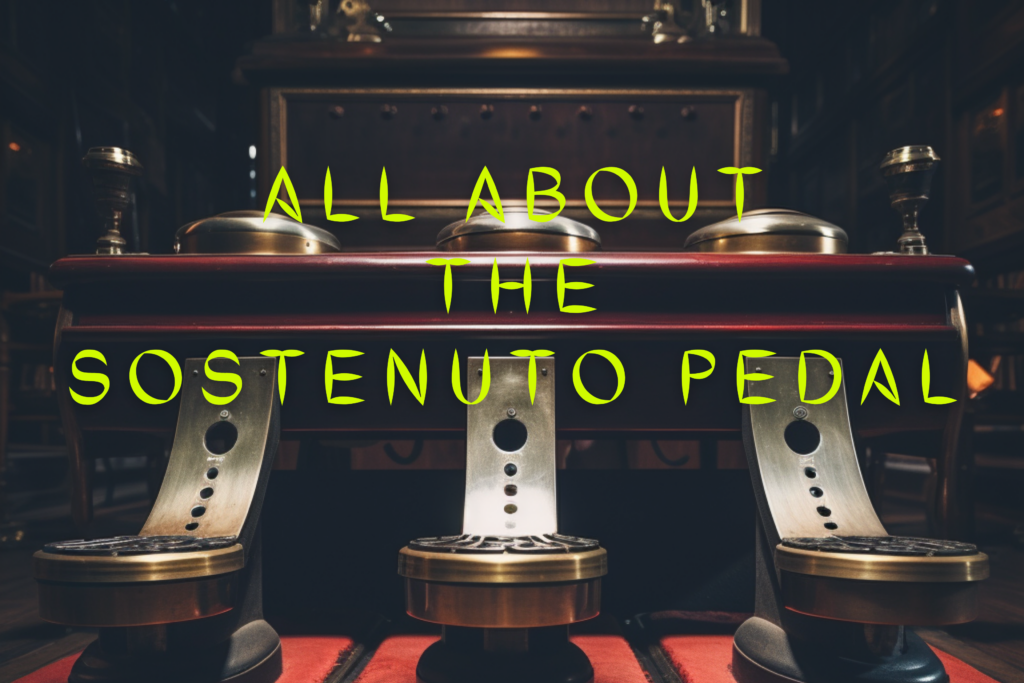Piano Lessons, Uncategorized
The Sostenuto Pedal: A Journey into Its History and Usage
All About Sostenuto Pedal – Sustain Pedal
Introduction
The piano, an instrument celebrated for its versatility and richness, is a marvel not just for its keys but also for its pedals. While most are familiar with the damper pedal, often used to sustain notes, there exists a less known yet fascinating pedal: the sostenuto pedal. This unique feature, often the middle pedal on a grand piano, is a tool of immense subtlety and expressive power. It allows pianists to sustain selected notes while leaving others unaffected, offering a layer of complexity and nuance to piano music.
This article delves into the intriguing world of the sostenuto pedal, exploring its history, mechanics, and its artistic use both in traditional and contemporary piano compositions.
A Brief History of the Sostenuto Pedal
The genesis of the sostenuto pedal, or also known as Sustain pedal, traces back to the 19th century, a period of prolific innovation in piano design. Originally conceived to enhance the expressive capabilities of the piano, its earliest known implementation was in France. However, it was in the United States where the pedal found its significant development, particularly with the prestigious Steinway & Sons. In 1874, Steinway patented a version of the sostenuto pedal, which was a substantial improvement over its European predecessors.
This pedal was integrated into the Steinway’s Model D grand pianos, marking a milestone in piano engineering. Over the years, the sostenuto pedal evolved, finding its place in various piano models, both grand and upright. It became a staple for classical compositions and an asset for concert pianists. Although not as commonly used as the damper pedal, its presence in modern pianos signifies the importance of subtle and sophisticated control in musical expression.
Understanding the Sostenuto Pedal Mechanics
To appreciate the sostenuto pedal’s uniqueness, one must understand its mechanics. Distinct from the damper pedal, which sustains all the notes played, the sostenuto pedal affects only the notes held down when it is pressed. This selective sustain mechanism is achieved through a complex system of levers and dampers. When pressed, the pedal locks the dampers in an elevated position only for those keys that are being held down. This intricate mechanism allows for selective sustaining of notes, enabling a pianist to sustain some notes while others remain unaffected. It’s like having a selective memory in the piano, holding onto certain sounds while letting go of others, adding a layer of emotional depth to the music.
The Art of Using the Sostenuto Pedal
The sostenuto pedal is not just a mechanical marvel; it’s an artistic tool that, when mastered, can transform a piano performance. Beginners might find it less intuitive compared to the universally used damper pedal, but its mastery opens up new dimensions in piano music. The basic use involves sustaining a chord or a set of notes to create a lingering, atmospheric sound while playing other notes staccato or without sustain. This technique allows for a juxtaposition of sustained and unsustained notes, creating a rich tapestry of sound.
Advanced pianists employ the sostenuto pedal for more intricate effects. For instance, in pieces with dense chordal structures, it can sustain a bottom layer of harmony while the upper layers are played with clarity and precision. In contemporary compositions, it’s often used to create a pedal point—a single, sustained tone over which changing harmonies are played.
However, there are common misconceptions about the sostenuto pedal. Some pianists mistakenly use it as a substitute for the damper pedal, which it is not. Its selective nature requires a deliberate and thoughtful approach. Misuse can lead to a muffled sound, where unintended notes are sustained.
The Sostenuto Pedal in Music Composition
Composers have long been fascinated by the expressive potential of the sostenuto pedal. Claude Debussy, for instance, used it to create ethereal soundscapes in his compositions, while Maurice Ravel employed it for its ability to sustain bass notes, creating a haunting resonance. In modern compositions, the pedal finds its use in creating layered sound effects, a technique often employed in cinematic and experimental music. It offers composers a unique tool to paint with sounds, adding depth and texture to their musical canvases.
Conclusion
The sostenuto pedal, or sustain pedal, though less known than its counterparts, plays a crucial role in the dynamics of piano music. Its ability to sustain selected notes adds a layer of complexity and expressiveness, making it an invaluable tool for both pianists and composers in their musical creations.

